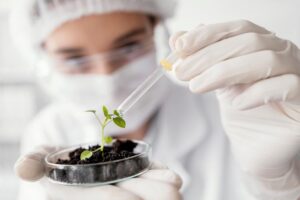In the last two decades, there has been a transformation in the general popularity of the topic of agricultural soils. Two decades ago, the impacts of climate change didn’t quality as a topic of conversation in the dinner table, let alone soil health or the ability of soils to store carbon. However, this scenario has changed. Soil and its health are becoming a proper kitchen table issue. Climate change has become a more pervasive and urgent political issue. In the following section of this blog, we shall share the details on the science behind soil carbon sequestration.

The Science Behind Soil Carbon Sequestration:
The carbon cycle that controls the flow of carbon between the atmosphere, the plants, and soil, is crucial for soil carbon sequestration. To photosynthesize, plants take in CO2 from the air and transform it into organic compounds like sugars that are used for energy and expansion. The plants leave organic content that is decomposed by the bacteria when they die or shed their leaves, branches, and roots. The remaining carbon gets converted into stable forms of carbon and is integrated into the soil during the process.
How Soil Carbon Sequestration Takes Place:
- Photosynthesis—Plants absorb CO2 from the atmosphere and use it, along with sunlight and water, to produce organic compounds like sugars. These compounds are used by the plant for growth and energy.
- Transfer of carbon into soil—When plants die or shed leaves, branches, and roots, they leave organic matter that is broken down by soil microbes.
- Carbon storage in the soil—The stable forms of carbon are stored in the soil as soil organic matter (SOM), which can persist within the soil for thousands of years.
- Carbon cycling—Carbon in the soil is constantly cycling through the soil microbial community, plant roots, and other soil organisms.
- Carbon loss – Carbon gets lost from the soil through disturbances like erosion, land use change, and wildfires.
Mechanisms of Climate Change Through Soil Carbon Sequestration:
The primary reason for excitement around the soils is the ability to hold on to carbon, draw it out of the atmosphere, and lock it away. The mechanism is relatively simple. When plants grow through photosynthesis, they draw CO2 out of the atmosphere and add it to the plants. The drawdown in the agricultural lands is quite dramatic.
After harvest, when the grain is removed and crop residue is returned to the soil, most of the carbon is returned to the atmosphere. Soil microbes use the residue as a food source, respiring CO2 like you and me. However, due to chemical bonds within the soil particles and organic molecules within the crop residue, some carbon sticks around, becoming soil organic carbon.
In average agricultural soil, the percentage of soil organic carbon typically is 1-2% of the total soil mass. This is relatively nominal. However, if we consider how much soil there is in the world, soils hold much more carbon than all the plants on Earth and in the atmosphere combined. They present a serious sink for the atmospheric carbon stored.
Why the Hype Around Agricultural Soils?
If the soils already hold such a significant amount of carbon, why do we think they could serve to store more? The answer is similar to many questions about climate change and carbon cycling. We humans have fundamentally altered soil carbon dynamics through their activities. Over the last 12,000 years, 133 petagrams of carbon were lost from the soils because of anthropogenic agricultural practices like land conversion, tillage, and over grazing. This is somewhat worrisome on its face, and it also presents a significant opportunity. If all the carbon were lost from agricultural soils, we could put some of it back, reducing the carbon dioxide concentration of the atmosphere and some of the worst effects of human-caused climate change.
The good thing about this is that all of this has enabled us to alter agricultural practices and store more carbon in the soil. Practices like adding cover crops, reducing soil disturbance and tillage, and integrating livestock into the crop fields help increase the amount of carbon in agricultural soils. The longer the practices are, the more the effects will continue to grow. These practice-changes underlie the burgeoning soil carbon markets and represent actionable steps. Of course, mileage might vary based on the climate, the soil type, and the specifics of how a farmer implements the practice, but these are how we can use soils as a reservoir for the atmospheric carbon drawdown.
In Conclusion:
Soil health is paramount for farmers facing food security, climate change, and environmental sustainability challenges. The primary component is soil carbon sequestration, a process that captures atmospheric carbon dioxide and stores it in the ground. The journey towards a much more sustainable and carbon-conscious future is challenging, but it is a journey that we ought to undertake. It is crucial to ensure higher crop productivity.
We here at SoilOptix® can provide you with a comprehensive analysis of your soil. Visit - https://soiloptix.com/ for more information.
